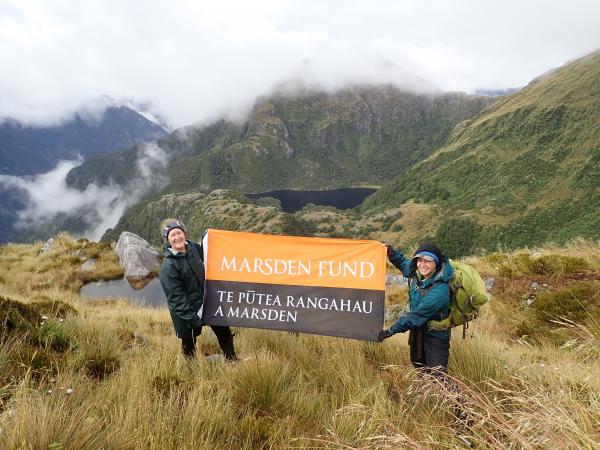Zircons in Zealandia
Dr Rose Turnbull from GNS has recently traveled to Fiordland to survey the crust of Zealandia, the continental shelf surrounding New Zealand. She is using the trace elements of zircon crystals in rocks to create a map of the surrounding mantle in 4D.
Dr Rose Turnbull has shared some photos showcasing the Marsden Fund flag from her recent field-trip to the wilderness of Fiordland. The boat was a cruise undertaken in December 2018 in Dusky Sound, southwest Fiordland. The shot in the hills was in Western Fiordland, which was taken on the only day the team got a break in the weather! See below for the photos and project summary.

Dr Rose Turnbull (left) and team member Elena (right), holding the Marsden Fund flag in the Western Fiordland
Dr Rose Turnbull holding the Marsden Fund flag on the Flightless
Project Summary - Marsden Fund contract GNS1701 'Probing the crust with zircon: a new pathfinder for mineral deposition?'
Minerals underpin human society, however, discovery rates of new resources are declining while
demand is increasing. Consequently, new innovative ideas are being developed to better predict
their formation and location. One such idea proposes that areas of juvenile crust adjacent to
long-lived trans-lithospheric structures are richly endowed in metal deposits. Specifically, these
trans-lithospheric structures are important conduits that variably connect metal-rich mantle
reservoirs at depth to the upper continental crust, concentrating both magmas and mineralising
fluids. We will use a novel approach that will ‘image’ such structures in Zealandia’s Western
Province by using the trace and isotopic composition of zircon crystals extracted from granitoid
rocks. Following a comprehensive multi-isotopic study of zircon from over 150 granitoids, we will
produce a series of isotopic contour maps that will map the 4D lithospheric architecture of
Zealandia’s Western Province. These multi-isotopic maps will allow crustal domains and
trans-lithospheric structures to be delineated, enhancing our capacity to predict the localisation of
the most prospective and metal endowed terranes in New Zealand. This study represents the first
time multi-isotopic mapping will have been tested in a continental margin setting, with important
implications for understanding similar orogenic belts worldwide, and assessing their metal
endowment.
